Computational Fluid Dynamics Modeling of Ammonia Concentration in a Commercial Broiler Building
Abstract
1. Introduction
2. Material and Methods
2.1. Broiler Building
2.2. Field Measurements
3. CFD Model
3.1. Geometry, Numerical Model, and Boundary Conditions
3.2. Simulated Periods or Configurations and Boundary Conditions
3.3. Mesh Independence Tests
4. Results and Discussion
4.1. Comparison of Experimental and Numerical Results for NH3 Concentration
4.2. Characterization of Indoor Air Flow for Different Configurations
4.2.1. Airflow Pattern
4.2.2. Ammonia Distribution
4.2.3. Velocity Distribution
5. Conclusions
Author Contributions
Funding
Institutional Review Board Statement
Data Availability Statement
Acknowledgments
Conflicts of Interest
References
- USAD of Agriculture. Livestock and Poultry: World Markets and Trade. USDA Foreign Agricultural Service. 2022. Available online: https://www.fas.usda.gov/data/livestock-and-poultry-world-markets-and-trade (accessed on 15 September 2022).
- Anderson, K.; Moore, P.A.; Martin, J.; Ashworth, A.J. Evaluation of a Novel Poultry Litter Amendment on Greenhouse Gas Emissions. Atmosphere 2021, 12, 563. [Google Scholar] [CrossRef]
- Pereira, J.L.S.; Ferreira, S.; Pinheiro, V.; Trindade, H. Ammonia, Nitrous Oxide, Carbon Dioxide and Methane Emissions from Commercial Broiler Houses in Mediterranean Portugal. Water Air Soil Pollut. 2018, 229, 377. [Google Scholar] [CrossRef]
- Naseem, S.; King, A.J. Ammonia production in poultry houses can affect health of humans, birds, and the environment-techniques for its reduction during poultry production. Environ. Sci. Pollut. Res. Int. 2018, 25, 15269–15293. [Google Scholar] [CrossRef] [PubMed]
- Bittman, S.; Sheppard, S.C.; Hunt, D. Potential for mitigating atmospheric ammonia in Canada. Soil Use Manag. 2017, 33, 263–275. [Google Scholar] [CrossRef]
- Pereira, J.L.S.; Garcia, C.; Trindade, H.; Pereira, J.L.S.; Garcia, C.; Trindade, H. Review of Measures to Control Airborne Pollutants in Broiler Housing; IntechOpen: London, UK, 2023. [Google Scholar] [CrossRef]
- Oliveira, M.D.; Sousa, F.C.; Saraz, J.O.; Calderano, A.A.; Tinôco, I.F.F.; Carneiro, A.P.S. Ammonia Emission in Poultry Facilities: A Review for Tropical Climate Areas. Atmosphere 2021, 12, 1091. [Google Scholar] [CrossRef]
- Berry Lott. Amônia. Avicultura Industrial. 2016. Available online: https://www.aviculturaindustrial.com.br/imprensa/amonia/20030711-113203-0098 (accessed on 15 September 2022).
- Broucek, J. Nitrous Oxide Release from Poultry and Pig Housing. Pol. J. Environ. Stud. 2018, 27, 467–479. [Google Scholar] [CrossRef]
- Anderson, K.; Moore, P.A., Jr.; Martin, J.; Ashworth, A.J. Effect of a new manure amendment on ammonia emissions from poultry litter. Atmosphere 2020, 11, 257. [Google Scholar] [CrossRef]
- Inoue, K.R.A.; Tinôco, I.d.F.F.; Cassuce, D.C.; Bueno, M.M.; Graña, A.L. Análise da Concentração de Amônia em Galpões de Frango de Corte Submetidos a Diferentes Dietas. Rev. Eng. Na Agric. Reveng. 2012, 20, 19–24. [Google Scholar] [CrossRef]
- Khan, D.R.; Wecke, C.; Liebert, F. An Elevated Dietary Cysteine to Methionine Ratio Does Not Impact on Dietary Methionine Efficiency and the Derived Optimal Methionine to Lysine Ratio in Diets for Meat Type Chicken. Open J. Anim. Sci. 2015, 5, 457–466. [Google Scholar] [CrossRef]
- Medeiros, R.; Santos, B.J.M.; Freitas, M.; Silva, O.A.; Alves, F.F.; Ferreira, E. A adição de diferentes produtos químicos e o efeito da umidade na volatilização de amônia em cama de frango. Cienc. Rural 2008, 38, 2321–2326. [Google Scholar] [CrossRef]
- Moore, P. Methods of Treating Manure. U.S. Patent 7011824, 14 March 2006. Available online: https://scholarworks.uark.edu/pat/121 (accessed on 9 September 2022).
- Vilela, M.D.O.; Gates, R.S.; Souza, C.D.F.; Junior, C.G.D.S.T.; Sousa, F.C. Nitrogen transformation stages into ammonia in broiler production: Sources, deposition, transformation and emission to environment. Dyna 2020, 87, 221–228. [Google Scholar] [CrossRef]
- Küçüktopcu, E.; Cemek, B.; Simsek, H.; Ni, J.-Q. Computational Fluid Dynamics Modeling of a Broiler House Microclimate in Summer and Winter. Animals 2022, 12, 867. [Google Scholar] [CrossRef] [PubMed]
- Blanes-Vidal, V.; Guijarro, E.; Balasch, S.; Torres, A.G. Application of computational fluid dynamics to the prediction of airflow in a mechanically ventilated commercial poultry building. Biosyst. Eng. 2008, 100, 105–116. [Google Scholar] [CrossRef]
- Gonçalves, J.C.; Costa, J.J.; Figueiredo, A.R.; Lopes, A.M.G. CFD modelling of aerodynamic sealing by vertical and horizontal air curtains. Energy Build. 2012, 52, 153–160. [Google Scholar] [CrossRef]
- Galdo, E.H.G. Evaluación de Alternativas en las Instalaciones Avícolas de Pollos de Carne para la Mejora de las Condiciones de Confort de los Animales; Instituto de Ciencia y Tecnología Animal, Universitat Politècnica de València: Valencia, Spain, 2017. [Google Scholar]
- Rong, L.; Nielsen, P.V.; Bjerg, B.; Zhang, G. Summary of best guidelines and validation of CFD modeling in livestock buildings to ensure prediction quality. Comput. Electron. Agric. 2016, 121, 180–190. [Google Scholar] [CrossRef]
- Iqbal, A.; Gautam, K.R.; Zhang, G.; Rong, L. Modelling of animal occupied zones in CFD. Biosyst. Eng. 2021, 204, 181–197. [Google Scholar] [CrossRef]
- Shin, H.; Kwak, Y.; Jo, S.-K.; Kim, S.-H.; Huh, J.-H. Applicability evaluation of a demand-controlled ventilation system in livestock. Comput. Electron. Agric. 2022, 196, 106907. [Google Scholar] [CrossRef]
- Pakari, A.; Ghani, S. Comparison of different mechanical ventilation systems for dairy cow barns: CFD simulations and field measurements. Comput. Electron. Agric. 2021, 186, 106207. [Google Scholar] [CrossRef]
- Tong, X.; Zhao, L.; Heber, A.J.; Ni, J.-Q. Development of a farm-scale, quasi-mechanistic model to estimate ammonia emissions from commercial manure-belt layer houses. Biosyst. Eng. 2020, 196, 67–87. [Google Scholar] [CrossRef]
- Li, H.; Rong, L.; Zong, C.; Zhang, G. A numerical study on forced convective heat transfer of a chicken (model) in horizontal airflow. Biosyst. Eng. 2016, 150, 151–159. [Google Scholar] [CrossRef]
- Li, J.; Suvarna, M.; Li, L.; Pan, L.; Pérez-Ramírez, J.; Ok, Y.S.; Wang, X. A review of computational modeling techniques for wet waste valorization: Research trends and future perspectives. J. Clean. Prod. 2022, 367, 133025. [Google Scholar] [CrossRef]
- Osorio, R.H.; Tinôco, I.F.; Mendes, L.; Guerra, L.G.; Barbari, M.; Baptista, F.J.; Tinôco, B.F. CFD modeling of the thermal environment in a negative pressure tunnel ventilated broiler barn during the first week of life. In Proceedings of the 7th European Conference on Precision Livestock Farming, Milan, Italy, 15–18 September 2015. [Google Scholar]
- Chepete, H.J.; Xin, H. Heat and Moisture Production of Poultry and Their Housing Systems: Pullets and Layers. ASHRAE Trans. 2004, 110, 286–299. [Google Scholar]
- Franco, A.; Valera, D.L.; Peña, A.; Pérez, A.M. Aerodynamic analysis and CFD simulation of several cellulose evaporative cooling pads used in Mediterranean greenhouses. Comput. Electron. Agric. 2011, 76, 218–230. [Google Scholar] [CrossRef]
- Fidaros, D.; Baxevanou, C.; Bartzanas, T.; Kittas, C. Numerical study of mechanically ventilated broiler house equipped with evaporative pads. Comput. Electron. Agric. 2018, 149, 101–109. [Google Scholar] [CrossRef]
- Küçüktopcu, E.; Cemek, B. Evaluating the influence of turbulence models used in computational fluid dynamics for the prediction of airflows inside poultry houses. Biosyst. Eng. 2019, 183, 1–12. [Google Scholar] [CrossRef]
- Yahav, S.; Straschnow, A.; Vax, E.; Razpakovski, V.; Shinder, D. Air Velocity Alters Broiler Performance Under Harsh Environmental Conditions1. Poult. Sci. 2001, 80, 724–726. [Google Scholar] [CrossRef]


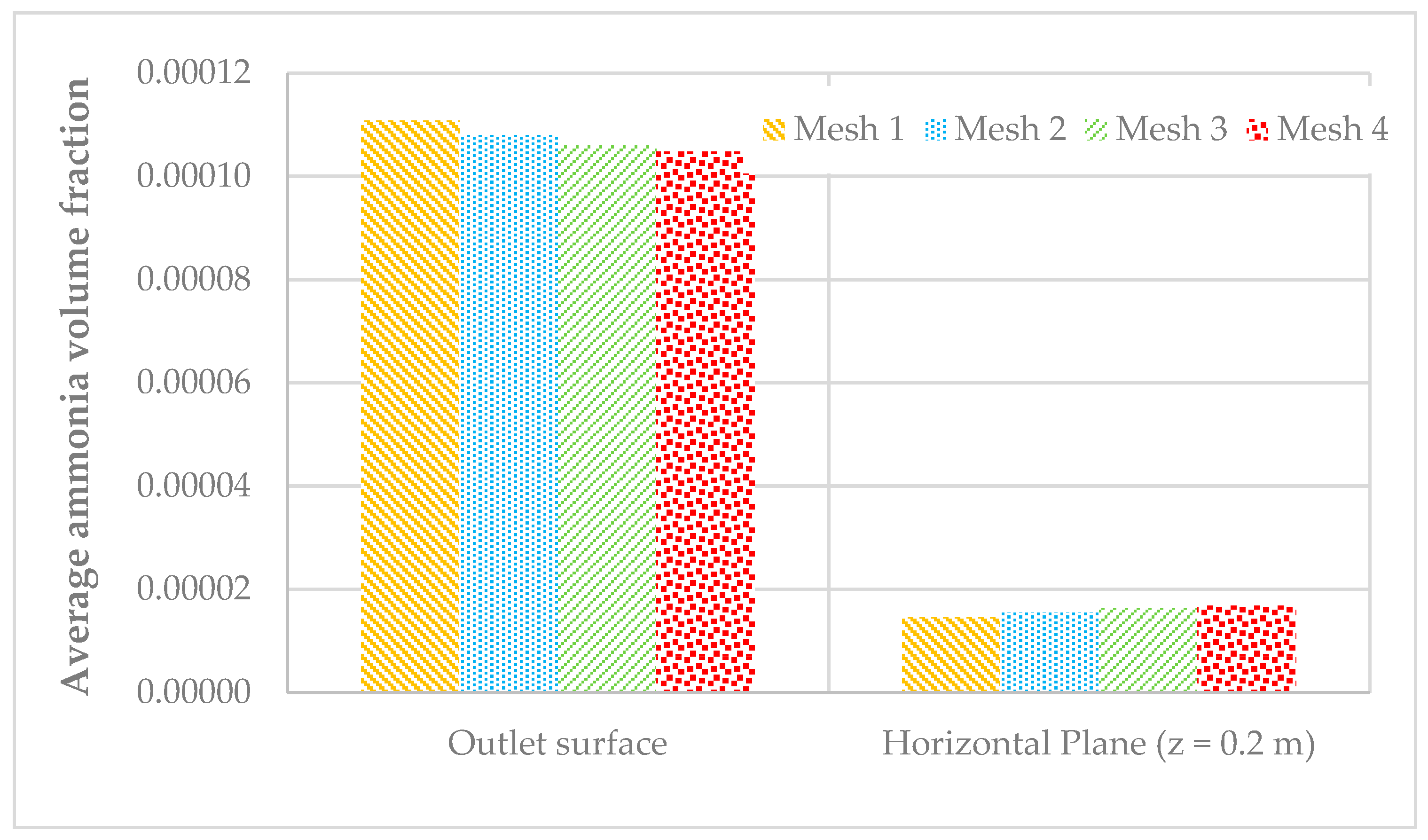
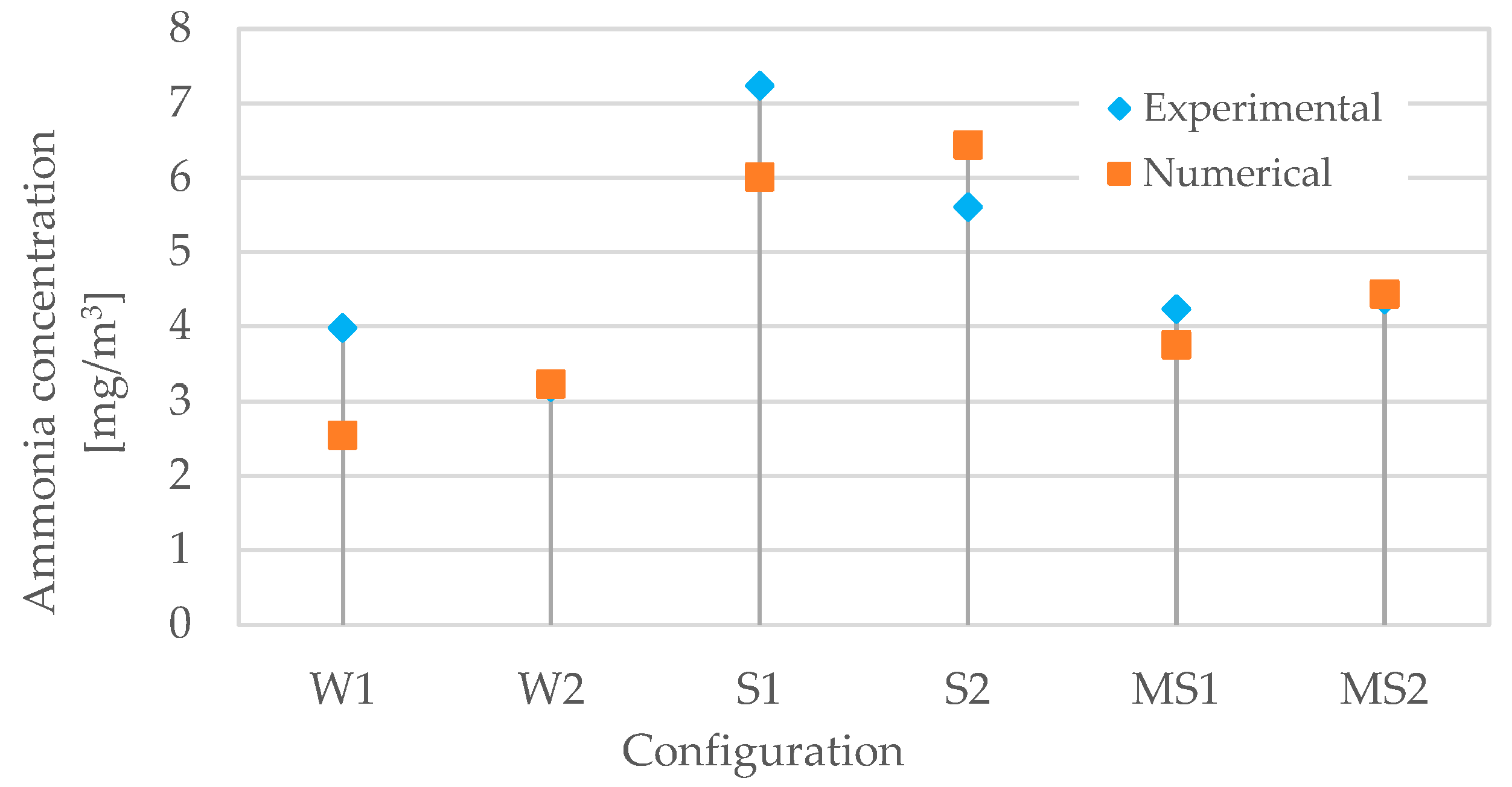



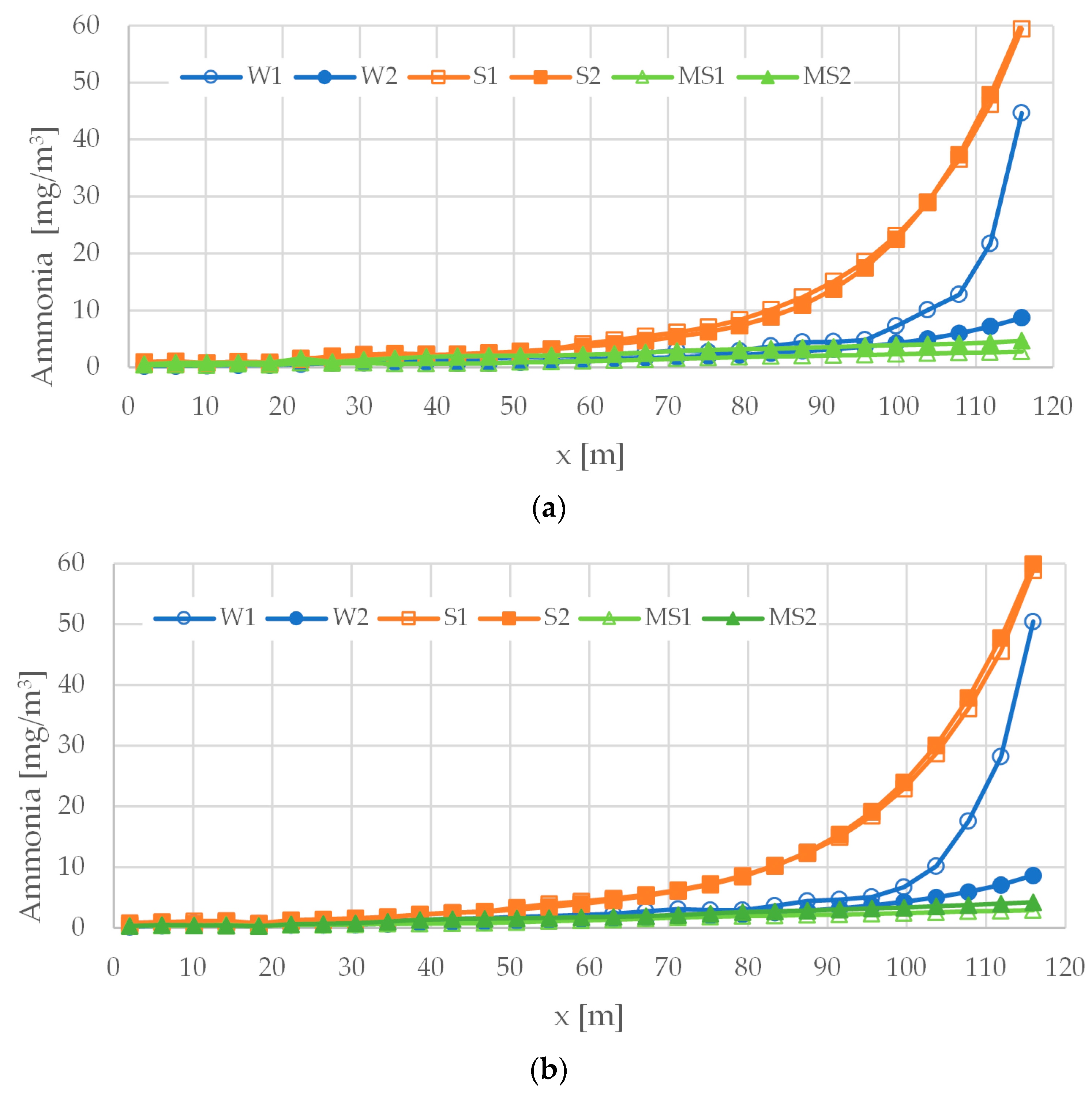
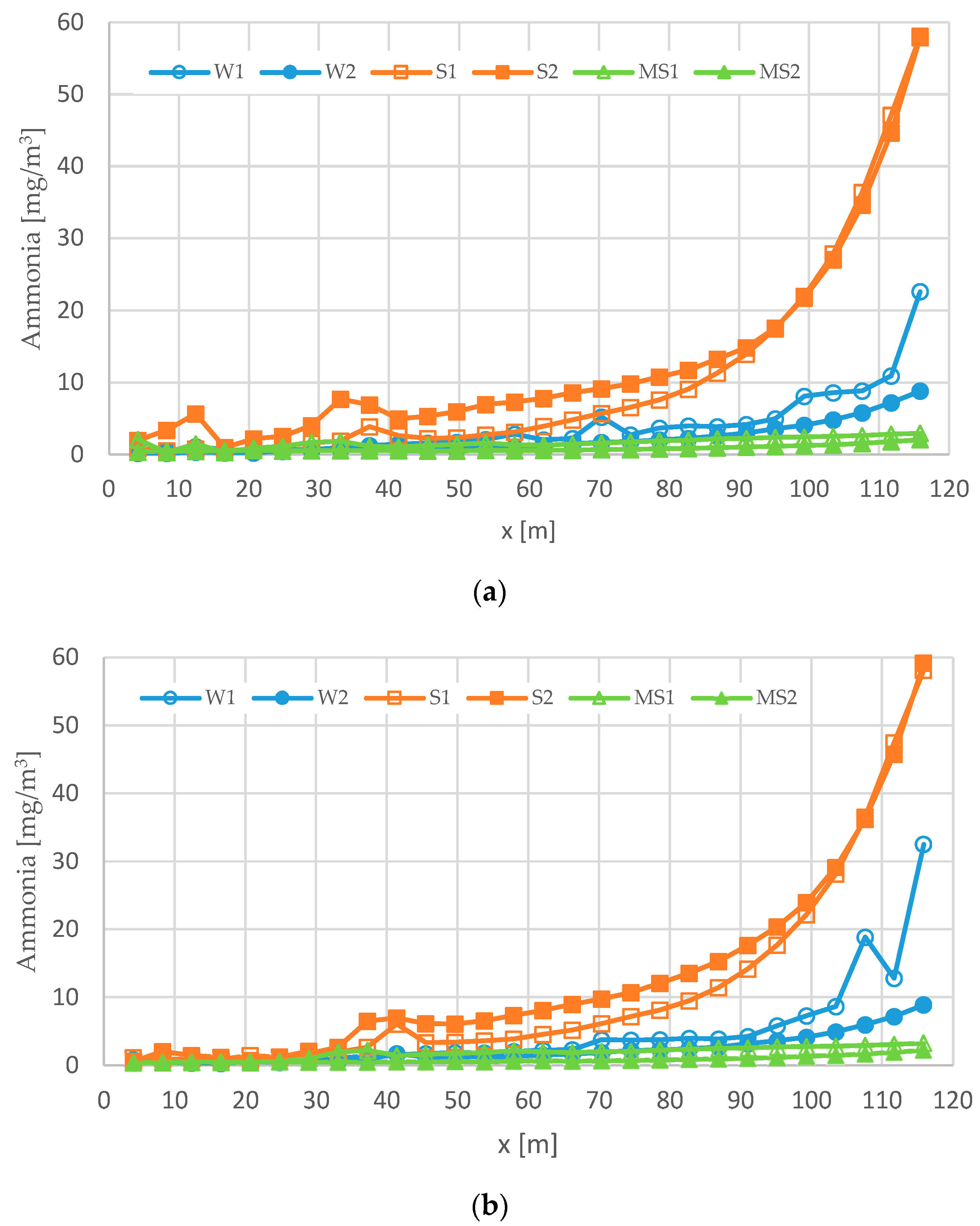
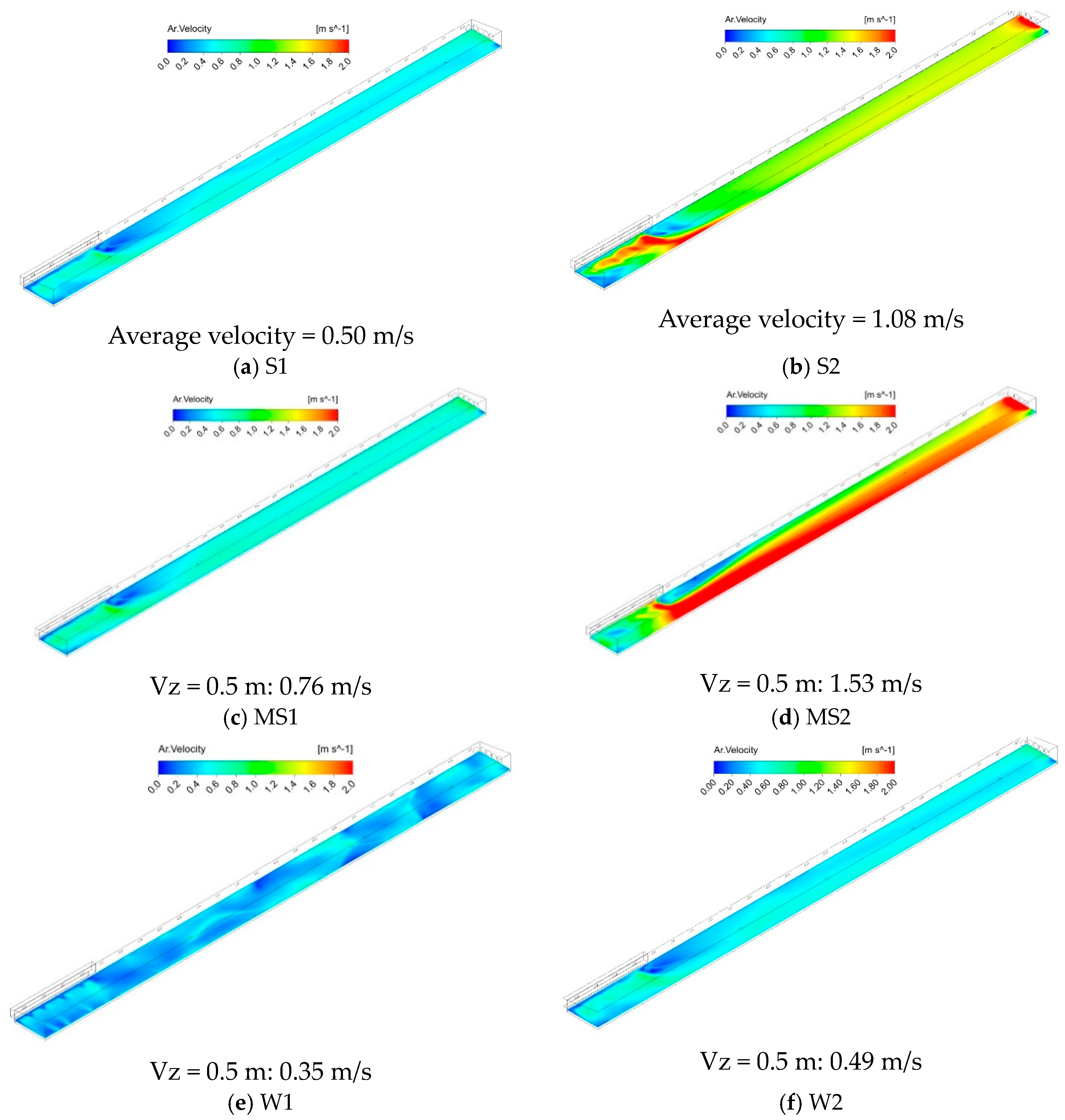
| Configuration | Season | Correspondent Date | Growth Period (day) | Hour of the Day (h) | Broilers Number | Liveweight (g) |
|---|---|---|---|---|---|---|
| W1 | Winter | 21 March 2018 | 31 | 6 | 37,180 | 1141.0 |
| W2 | Winter | 21 March 2018 | 31 | 14 | 37,153 | 1170.0 |
| S1 | Summer | 23 July 2018 | 28 | 6 | 36,309 | 1214.1 |
| S2 | Summer | 23 July 2018 | 28 | 14 | 36,292 | 1245.0 |
| MS1 | Mid-season | 7 October 2017 | 30 | 6 | 38,718 | 1515.6 |
| MS2 | Mid-season | 7 October 2017 | 30 | 14 | 38,712 | 1533.0 |
| Configuration | Tint (°C) | Hrint (%) | Tout (°C) | Hrout (%) | Outlet Volume Flow Rate (m3/h) | Outlet Mass Flow Rate (kg/s) | NH3 Litter Emission (kg/(m2·s)) | Broiler Heat Released (W/m2) |
|---|---|---|---|---|---|---|---|---|
| W1 | 24.0 | 61.6 | 6.0 | 65.4 | 46,300.3 | 16.0 | 2.87 × 10−8 | 220.95 |
| W2 | 25.3 | 59.0 | 13.2 | 54.7 | 72,906.9 | 22.0 | 3.44 × 10−8 | 226.40 |
| S1 | 26.1 | 80.9 | 19.6 | 88.2 | 90,620.5 | 30.2 | 9.40 × 10−8 | 344.39 |
| S2 | 29.1 | 62.7 | 25.9 | 55.5 | 210,754.2 | 70.3 | 1.86 × 10−07 | 353.00 |
| MS1 | 24.7 | 73.4 | 9.5 | 94.3 | 115,777.4 | 39.1 | 6.99 × 10−8 | 305.06 |
| MS2 | 30.4 | 39.2 | 28.7 | 26.9 | 300,510.0 | 100.7 | 1.90 × 10−7 | 309.09 |
| No. Nodes | No. Elements | |
|---|---|---|
| Mesh 1 | 479,973 | 165,6020 |
| Mesh 2 | 608,814 | 234,3413 |
| Mesh 3 | 1,222,894 | 5478,648 |
| Mesh 4 | 2,241,341 | 1,058,1101 |
Disclaimer/Publisher’s Note: The statements, opinions and data contained in all publications are solely those of the individual author(s) and contributor(s) and not of MDPI and/or the editor(s). MDPI and/or the editor(s) disclaim responsibility for any injury to people or property resulting from any ideas, methods, instructions or products referred to in the content. |
© 2023 by the authors. Licensee MDPI, Basel, Switzerland. This article is an open access article distributed under the terms and conditions of the Creative Commons Attribution (CC BY) license (https://creativecommons.org/licenses/by/4.0/).
Share and Cite
Gonçalves, J.C.; Lopes, A.M.G.; Pereira, J.L.S. Computational Fluid Dynamics Modeling of Ammonia Concentration in a Commercial Broiler Building. Agriculture 2023, 13, 1101. https://doi.org/10.3390/agriculture13051101
Gonçalves JC, Lopes AMG, Pereira JLS. Computational Fluid Dynamics Modeling of Ammonia Concentration in a Commercial Broiler Building. Agriculture. 2023; 13(5):1101. https://doi.org/10.3390/agriculture13051101
Chicago/Turabian StyleGonçalves, João C., António M. G. Lopes, and José L. S. Pereira. 2023. "Computational Fluid Dynamics Modeling of Ammonia Concentration in a Commercial Broiler Building" Agriculture 13, no. 5: 1101. https://doi.org/10.3390/agriculture13051101
APA StyleGonçalves, J. C., Lopes, A. M. G., & Pereira, J. L. S. (2023). Computational Fluid Dynamics Modeling of Ammonia Concentration in a Commercial Broiler Building. Agriculture, 13(5), 1101. https://doi.org/10.3390/agriculture13051101








